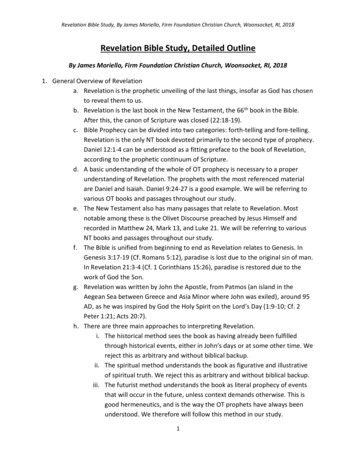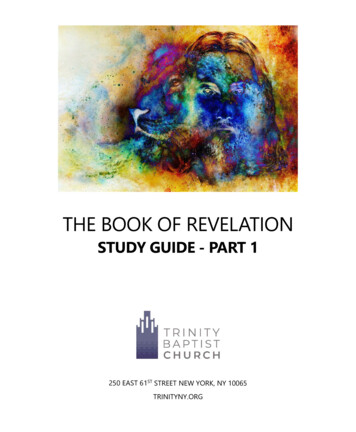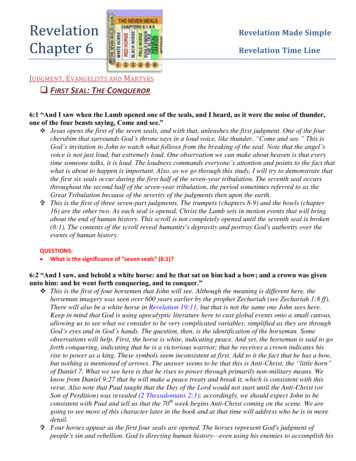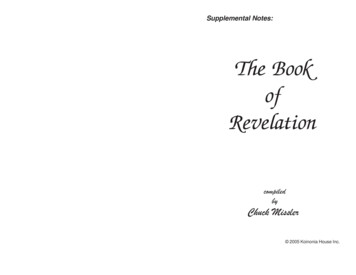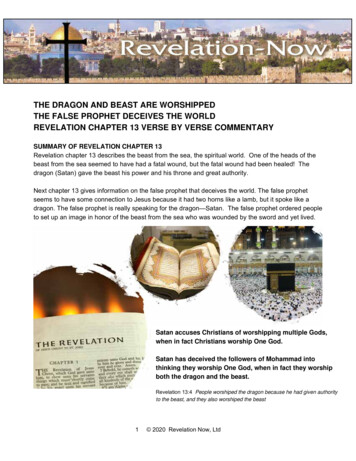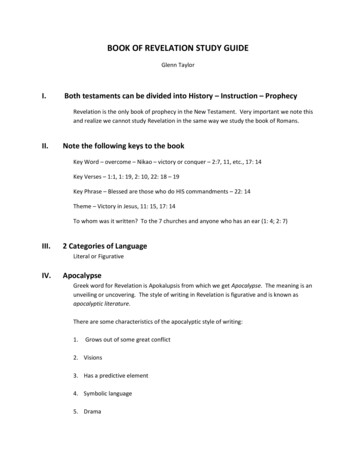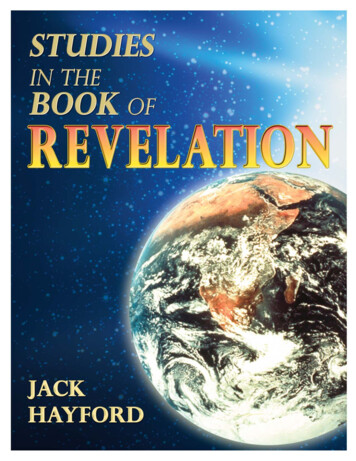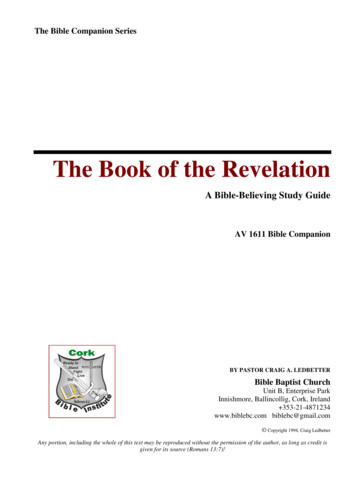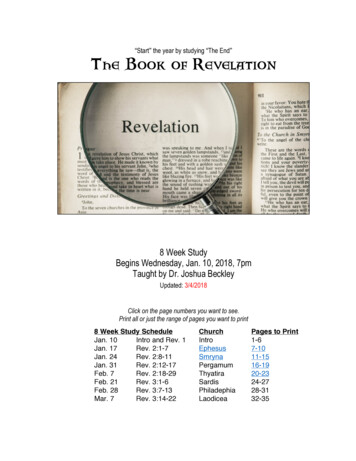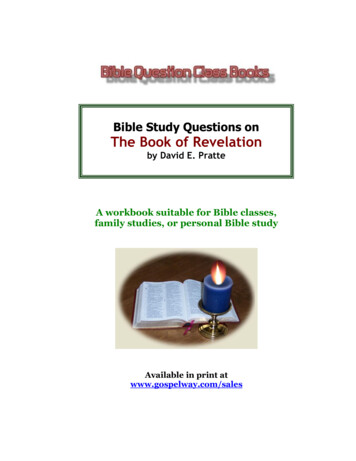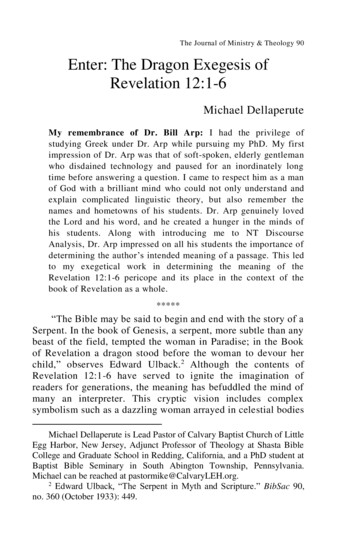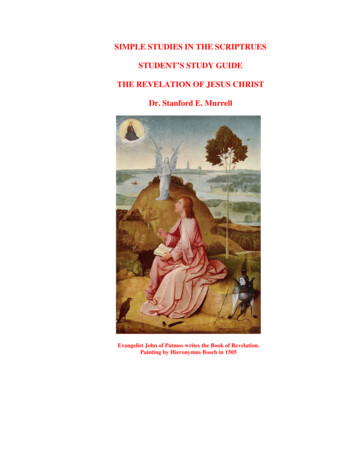
Transcription
SIMPLE STUDIES IN THE SCRIPTRUESSTUDENT’S STUDY GUIDETHE REVELATION OF JESUS CHRISTDr. Stanford E. MurrellEvangelist John of Patmos writes the Book of Revelation.Painting by Hieronymus Bosch in 1505
The Revelation of Jesus ChristHuman Author: JohnDivine Author: God the Holy SpiritEarly date prior to AD 70Late date c. AD 90-95Key word: Christ is LordKey Verse: Revelation 19:6“And I heard as it were the voice of a great multitude, and as the voice of many waters, and asthe voice of mighty thunderings, saying, Alleluia: for the Lord God omnipotent reigneth.”The Story Behind the RevelationBetween AD 66 and AD 70, the prophetic utterances of Jesus in Matthew 24, Mark 13, and Luke21 began to be fulfilled. Briefly the known facts can be stated. In the summer of the year AD 66,a Jewish revolt broke out in Jerusalem. Led by fanatical zealots this revolt took place against theoverbearing Roman procurator named Gessius Florus. From May through November the Jewsreacted against his oppressive reign. As a result, Neapolitanus, a Roman military tribune, wassent from Antioch by Cestius Gallus, the Roman governor of Syria, to try to calm the Jews. TheJews refused to be pacified and in the battle that followed they actually gained an advantageagainst the troops of the governor of Syria. Cestius had to order a retreat, much to the delight ofthe Jews. It was not long before word finally reached the emperor Nero in Rome about theexplosive situation unfolding in Israel. After deliberation, Nero commissioned a seasonedgeneral, Vespasian, to put down the revolt against imperial Rome and to restore the Pax Romana(the Roman peace). War against the Jews in Jerusalem was officially declared in February, AD67, when Vespasian received his commission from Nero. In the Spring of AD 67, Vespasianfinally arrived to take charge of the operations in Jerusalem. But the Jews proved to be a strongand resourceful people, not easily subdued. They desperately wanted to be free of Romanbondage and were willing to die for the cause of freedom. History records that Jerusalem didfinally fall to Titus, the son of Vespasian, who took charge of the siege in the late summer of AD70. For about forty-two months the Jewish people held out against the greatest military power onthe face of the earth.In broad strokes this was the terrible picture of death and destruction, violence and chaosbetween AD 66 and AD 70. The words of Jesus in Matthew 24, Mark 13, and Luke 21 and thewords of John in the Revelation can be used to paint in the details of this period. What will beseen is a historical fulfillment of the great tribulation that Jesus predicted would come upon thegeneration He ministered to. These were days of vengeance as God poured out His wrath onthose who dared to kill His Son (Luke 21:22). For forty-two months, for 1,260 days, for threeand one half years, the Roman army made war with Israel and during that awful period of timethe four horsemen of the apocalypse rode. The evidence is compelling for a historical fulfillmentof the Lord's prophetic utterances of great tribulation upon Israel in particular in AD 70. Theinstrument of divine wrath and justice would be the Zealots of the Jewish community and themilitary might of the Roman government. Though Rome would be a terrible instrument in thehand of God the empire would also come under judgment. It is the way of the Lord to use evil to2
judge evil and then to administer justice on the instrument of wrath. The book of Habakkukestablishes this divine method of operation. Those who were present during the events of the firstcentury testify to the judgment of God upon the earth. One of the leading eyewitnesses for thehistory of this time was the historian Josephus. His writings are helpful in reconstructing whathappened in AD 70.A Date to RememberSome Bible scholars place the dating for the Revelation c. AD 90. Other Bible scholars argue foran earlier dating of the Revelation, prior to the fall of Jerusalem in AD 70. The primary externalwitness for a late date is Irenaeus (AD 130-202). All other sources such as Clement ofAlexandria, Origen, Victorinus, and Jerome simply quoted from him. The particular statementmade by Irenaeus to date Revelation late is found in Book 5 of his Against Heresies (5:30:3.)."We will not, however, incur the risk of pronouncing positively as to the name of the Antichrist[found in Revelation 13]; for if it were necessary that his name should be distinctly revealed inthis present time, it would have been announced by him who be held the apocalyptic vision. Forthat [i.e., the vision or “he”, John] was seen no very long time since, but almost in our day,towards the end of Domitian's reign."At first, the statement seems conclusive until it is remembered that the original work of Irenaeusdoes not exist any longer. His writings have come down the centuries from the Latin versionwith some exception. In the translation there is a question as to whether Irenaeus meant to saythe vision of the Apocalypse belongs to Domitian's reign or John himself was seen "no very longtime since." The truth of the matter is that the Domitianic date cannot be established withabsolute certainty from any external evidence. Furthermore, there is no direct evidence inRevelation itself to establish a late date for its writing. However, John was told he was to seethings that must shortly come to pass. This is significant for John was writing to seven churchesthat desperately needed a message from the Lord. There is good reason to accept an early datefor the writing of the Revelation in that comfort could be given to the people of God in the firstcentury swept up in turbulent times that their four great enemies, the Dragon (satanicopposition), the Beast (political opposition), the False Prophet (religious opposition) and death(the final enemy), would soon be destroyed. And they were.The Last Letter: Lord of the Church Chapters 1-3The Prologue: A Preview of Coming Glory: Revelation 1:1-4SummaryRevelation Chapter 1Chapter one is a general preface to the whole book. The purpose of the work is declared(Revelation 1:1-2). There is an apostolic blessing pronounced on all who shall read the book witha view to honoring its principles (Revelation 1:3-8). Finally, a glorious vision or appearance ofthe resurrected Christ is given to the apostle John (Revelation 1:9-20).3
REVELATION 11 The Revelation [lit. unveiling] of Jesus Christ, which God gave unto him, toshew unto his servants things which must shortly come to pass; and he sent andsignified it by his angel unto his servant John:1:1 Many truths about the ascended Christ will be unveiled to John for this work is not about theanti-Christ or end time matters. It is about the Lord Jesus coming to judge the nation thatcrucified Him and vindicate the saints who follow Him. Matthew Henry notes “These events (itis said) were such as should come to pass not only surely, but also shortly; that is, they wouldbegin to come to pass very shortly, and the whole would be accomplished in a short time. Fornow the last ages of the world had come.”2 Who bare record of the word of God, and of the testimony of Jesus Christ, andof all things that he saw.3 Blessed is he that readeth, and they that hear the words of this prophecy [divinerevelation], and keep those things which are written therein: for the time is at hand.1:3 There are other blessings to be found in the Revelation. There is a blessing for those who die in the sphere of faith (Revelation 14:13). There is a blessing for those who are holy (Revelation 16:15). There is a blessing for those who are invited to the marriage supper of the Lamb (Revelation19:9). There is a blessing for those who have a part in the first resurrection (Revelation 20:6). There is a blessing for those who are obedient to the gospel (Revelation 22:14).Commenting on the blessings Matthew Henry observes the following. It is a blessed privilege to enjoy the oracles of God. This was one of the principal advantagesthe Jews had above the Gentiles. It is a blessed thing to study the scriptures; those are well employed who search thescriptures. It is a privilege not only to read the scriptures ourselves, but to hear them read by others, whoare qualified to give us the sense of what they read and to lead us into an understanding ofthem.4
It is not sufficient to our blessedness that we read and hear the scriptures, but we must keepthe things that are written; we must keep them in our memories, in our minds, in ouraffections, and in practice, and we shall be blessed in the deed. The nearer we come to the accomplishment of the scriptures, the greater regard we shall giveto them. The time is at hand, and we should be so much the more attentive as we see the dayapproaching.1:3 The time is at hand. In the following verses it is revealed that God lifts the curtain of time toreveal a portion of the future to the Church. Read Amos 3:7; Daniel 2:28; Matthew 11:25; Luke8:10.4 John to the seven churches which are in Asia: Grace be unto you, and peace,from him which is, and which was, and which is to come; and from the sevenSpirits [Holy Spirit Isa. 11:2; Zech. 3:9; 4:10] which are before his throne;1:4 The seven churches were located in the providence of western Asia Minor, which is roughlyequivalent to modern day Turkey. Because the Roman province of Asia included more churchesthan these seven the question arises as to why John singled out only seven. One possibility is thatthese seven cities may have been centers of seven postal districts. These seven churches all standon the great circular road, which formed a rough circle around the west central part of the Romanprovince of Asia. As such, these seven cites served as good centers of communication for thesurrounding districts. Letters in the first century had to be handwritten, and a letter sent to oneassembly would be passed on to be read by Christians in other congregations.1:4 The letters to the seven churches called for the Christians to repent of sin and return tofaithfulness and good works; encouraged them to stand firm for Christ against the temptations,trials, and persecutions of the Roman Empire; and promised specific rewards to the martyrs whofaced death without denying Christ (Nelson's Illustrated Bible Dictionary).The Command to Communicate 1:9-205 And from Jesus Christ, who is the faithful witness, and the first begotten of thedead [Revelation 20:6; 1 Cor. 15], and the prince of the kings of the earth. Untohim that loved [lit. loves], us, and washed us from our sins in his own blood[sanctification],1:5 There are three titles of Christ in this passage. Jesus is the Faithful Witness [of God theFather]; the First Begotten of the Dead [in that He never died again]; and the Prince [Ruler] ofthe Kings1:5 The death of Christ and His atoning work was limited to those whom He loves and washed“in His own blood.” If Christ had died for all men in the same manner then there are people inhell for whom He made atonement for sin.5
6 And hath made us kings and priests unto God and his Father [glorification]; tohim be glory and dominion for ever and ever. Amen.1:6 There are four glorious doxologies in Revelation as per Revelation 1:6; 5:11; 5:13 and 7:12.7 Behold, he cometh with clouds; and every eye shall see him [i.e., every eyewithout distinction not without exception], and they also which pierced him [i.e.,the Jews of the first century]: and all kindreds of the earth shall wail because ofhim. Even so, Amen.1:7 The concept of the Lord dwelling or coming in clouds to the nations of the earth is taught inother passages of Scripture (Psalm 104:3; 18:7-15; Isaiah 19:1; Mark 13:26).8 I am Alpha and Omega [first and last letters of the Greek alphabet], thebeginning and the ending, saith the Lord, which is, and which was, and which is tocome, the Almighty.9 I John, who also am your brother, and companion in tribulation, and in thekingdom and patience of Jesus Christ, was in the isle that is called Patmos [a smallbarren rocky island 35 miles off the coast of Asia Minor, 60 miles from Ephesus],for the word of God, and for the testimony of Jesus Christ.1:9 The small, barren rocky island of Patmos is located in the Aegean Sea about 60 miles fromEphesus. It was about ten miles long and six miles wide. Christians were put on the island forpolitical, economic and religious reasons. It is possible that John was no longer on the isle ofPatmos when he wrote the revelation for he says that he “was” on the isle of Patmos.Spiritual application. John becomes an example to all believers to persevere in the sphere ofsaving faith. Those who endure to the end shall be saved (Matt. 10:22).10 I was in the Spirit on the Lords day, and heard behind me a great voice, as of atrumpet,Spiritual application. The Lord’s Day refers to Sunday, the first day of the week. It is the newday of worship for the believers in honor of the resurrection of Christ (Acts 20:7; 1 Cor. 16:2;John 20:19-26).11 Saying, I am Alpha [the beginning] and Omega [the end], the first and the last:and, What thou seest, write in a book, and send it unto the seven churches whichare in Asia; unto Ephesus, and unto Smyrna, and unto Pergamos, and untoThyatira, and unto Sardis, and unto Philadelphia, and unto Laodicea.6
Spiritual application. The resurrected Lord does not hesitate to identify Himself through varioustitles as very God of very God. The Saviour of men’s souls is the Almighty One (cf. Revelation1:8). Christ is able to save to the uttermost those who come to Him.12 And I turned to see the voice that spake with me. And being turned, I sawseven golden candlesticks [Ex. 25:37];13 And in the midst of the seven candlesticks [lamp stands] one like unto the Sonof Man [cf. Matt. 16:13], clothed with a garment down to the foot, and girt aboutthe paps with a golden girdle [in the robe of a judge].14 His head and his hairs were white like wool, as white as snow [a symbol ofpurity]; and his eyes were as a flame of fire [a symbol of judgment];15 And his feet like unto fine brass, as if they burned in a furnace; and his voiceas the sound of many waters [signifying authority].16 And he had in his right hand seven stars: and out of his mouth went a sharptwo-edged sword: and his countenance [face] was as the sun shineth in hisstrength.17 And when I saw him, I fell at his feet as dead. And he laid his right hand uponme, saying unto me, Fear not; I am the first and the last:18 I am he that liveth, and was dead; and, behold, I am alive for evermore, Amen;and have the keys of hell [hades, the sphere of death] and of death.19 Write the things which thou hast seen, and the things which are, and the thingswhich shall be hereafter;20 The mystery [hidden truth] of the seven stars which thou sawest in my righthand, and the seven golden candlesticks. The seven stars are the angels[messengers] of the seven churches: and the seven candlesticks [lamp stands]which thou sawest are the seven churches.SummaryThe seven stars are the angels of the seven churches; the seven candlesticks are the sevenchurches of Asia; the sharp two-edged sword is the word of God (cf. Heb.4: 12); and the keys ofhell and death represent authority.7
Student’s Study GuideQuestions and Answers on Revelation 11. What words in Revelation 1:1 and 1:7 suggest that John was speaking to his generation?Answer.2. Of whom does the Revelation concern (Revelation 1:1)?Answer.3. Why was the Revelation given to Christ (Revelation 1:2)?Answer.4. According to 2 Timothy 3:16 who is the divine author of the Revelation?Answer.5. Who is the human author of the Revelation (Revelation 1:1)?Answer.6. What title does the author give to himself (Revelation 1:1)?Answer.7. How can a person receive a blessing from studying the Revelation (Revelation 1:3)?Answer.8. Study the following passages and tell what other blessings are to be found in the Revelation:14:13; 16:15; 19:9; 20:6; 22:7; 22:14.Answer. Revelation 14:13 Revelation 16:15 Revelation 19:98
Revelation 20:6 Revelation 22:7 Revelation 22:149. Where are the seven churches located to whom John initially writes (Revelation 1:4)?Answer.10. List the seven churches (Revelation 1:4 cf. 1:11).Answer. 11. The number seven occurs frequently in the Revelation. State what is referred to in thefollowing passages.Answer. Revelation 1-3 Revelation 1:4 Revelation 1:16 Revelation 4:5 Revelation 5:1 Revelation 5:6 Revelation 5:6 Revelation 8:2 Revelation 8:2 Revelation 10:3 Revelation 12:3 Revelation 12:3 Revelation 15:1 Revelation 17:1 Revelation 17:9 Revelation 17:109
12. In light of Isaiah 11:2 what might be meant by the “seven Spirits which are before thethrone” (Revelation 1:4)?Answer.13. List three titles of Christ from Revelation 1:5.Answer. 14. What is the divine attitude toward the saints (Revelation 1:5)?Answer.15. What has Christ done for His own with His blood (Revelation 1:5)?Answer.16. Are believer’s kings and priests unto God today? If not, why not and if so, in what way(Revelation 1:6)?Answer.17. Must Revelation 1:7 refer to the Second Advent of Christ (Acts 1:11 cf. Heb. 9:28) or can itrefer to a coming in judgment upon Jerusalem in AD 70? Use Scripture to defend youranswer.Answer.18. What title(s) of deity is ascribed to Christ in Revelation 1:8?Answer.19. Where was John when he saw the Revelation (Revelation 1:9)?Answer.10
20. How does John describe himself in relation to the other saints to whom he writes?Answer.21. Why was John on the isle (Revelation 1:9)?Answer.22. On what day of the week did John begin to write his vision (Revelation 1:10)?Answer.23. What title is given to the voice John heard (Revelation 1:11)?Answer.24. What did John see when he turned to face a voice that spoke to him (Revelation 1:12, 13)?Answer.25. John says he saw one like unto “the Son of Man”. Who is the Son of Man and how is Hedressed in the vision (Revelation 1:13-16)?Answer. Garment. Chest. Head and hair. Eyes. Feet. Voice. Right hand. Mouth.26. Interpret the following symbols: seven candlesticks; seven stars; sharp two-edged sword; thekeys of hell and death (Revelation 1:13, 16, 18, and 20).11
Answer. 27. What was John’s reaction when He saw the Son of Man (Revelation 1:17)?Answer.28. What was John commanded to do (Revelation 1:19)?Answer.29. What threefold division is given in Revelation 1:19?Answer. Personal Application and Reflections1. Do you believe most of the events in Revelation have been fulfilled historically? If not whynot? What part is yet to be fulfilled?2. Do you believe that Jesus is now, at this moment King of kings and Lord of lords? If so, ofwhom is He the king? (see Matthew 28:18-20)3. Have you ever considered yourself to be a king and a priest unto the Most High God, not inthe future but now? What are the implications of this concept if embraced?4. Is the Christian’s Lord’s Day a replacement of the Jewish Sabbath? If so, in what way and ifnot why not?5. How does a person distinguish what is literal and what is symbolic in the Revelation? Whatguidelines would you adopt for understanding the narrative? Be specific.12
Hiding God’s Word in My HeartRevelation 1:4 John to the seven churches which are in Asia: Grace be unto you, and peace,from him which is, and which was, and which is to come; and from the seven Spirits which arebefore his throne; 5 And from Jesus Christ, who is the faithful witness, and the first begotten ofthe dead, and the prince of the kings of the earth. Unto him that loved us, and washed us fromour sins in his own blood, 6 And hath made us kings and priests unto God and his Father; to himbe glory and dominion for ever and ever. Amen.13
SummaryRevelation Chapter 2SummaryRevelation Chapter 2The apostle John, having in chapter 1 written about the things which he had seen, now proceedsto write about the things that are, according to the command of God (Rev 1:19). The textconcerns itself with the present state of the seven churches of Asia, with which John had aspecial interest and for which he had a tender concern. The apostle was directed to write to everyone of the churches according to their present state and circumstances, and to inscribe everyletter to the angel of that church. The ministers are called angels because they are the messengersof God to mankind. In this chapter we have the following. The message sent to EphesusThe message sent to SmyrnaThe message sent to PergamosThe message sent to ThyatiraRevelation 2:1-7Revelation 2:8-11Revelation 2:12-17Revelation 2:18-29REVELATION 2Seven Messages to the Seven ChurchesThe Message to EphesusRevelation 2:1-71 Unto the angel of the Church of Ephesus write; These things saith he thatholdeth the seven stars in his right hand, who walketh in the midst of the sevengolden candlesticks;2:1 the Church of Ephesus. The city of Ephesus was an important commercial and religiouscenter in Asia Minor. The temple of the goddess Artemis [Diana] was in Ephesus. The otherchurches in Asia Minor looked to the bishop of Ephesus for spiritual guidance.2 I know thy works, and thy labour, and thy patience, and how thou canst notbear [tolerate] them which are evil: and thou hast tried them which say they areapostles, and are not, and hast found them liars:3 And hast borne, and hast patience, and for my names sake hast laboured, andhast not fainted.4 Nevertheless I have somewhat against thee, because thou hast left thy first love.5 Remember therefore from whence thou art fallen, and repent, and do the firstworks; or else I will come unto thee quickly, and will remove thy candlestick outof his place, except thou repent.14
6 But this thou hast, that thou hatest the deeds of the Nicolaitans which I alsohate.2:6 The teaching of the Nicolaitans included the belief that it was lawful to self-indulge andworship idols. They also taught that God was not the creator of the world. Immorality waspermissible in order for the grace of God to flow more freely.7 He that hath an ear, let him hear what the Spirit saith unto the churches; Tohim that overcometh will I give to eat of the tree of life, which is in the midst ofthe paradise of God.2:7 Genesis 3:24 records how God set a cherub to guard the way of the Tree of Life. Theguardian angel was placed there in grace lest man eat of the tree in an unregenerate state and beconfirmed in evil. Now, through Christ, individuals are invited to freely eat of the Tree of Life.The Message to SmyrnaRevelation 2:8-118 And unto the angel of the Church in Smyrna [40 miles N of Ephesus] write;These things saith the first and the last, which was dead, and is alive;2:8 Located in the Roman province of Asia 50 miles north of Ephesus on the Aegean shore,Smyrna was a jewel of prosperity and culture. A temple dedicated to the Emperor Tiberius hadbeen erected in the city. As a result emperor worship was embraced which led to a period ofpersecution for Christians who would not show their political loyalty by acts of emperorworship. Polycarp, a former disciple of the apostle John and bishop of Smyrna became thetwelfth martyr. The modern Turkish city of Izmir has been built over the ruins of Smyrna.Spiritual application. The word “church” refers to a called out assembly. Dr. Mark Deversuggests that a true church will be characterized by the following. Expositional preaching.A commitment to a biblical theology that seeks to understand God's character and His ways.The Gospel, which is the message of salvation based on Jesus Christ.The necessity of conversion.Evangelism.An active membership in a local church.Biblical church discipline.A concern for discipleship and spiritual growth.Biblical church leadership (Nine Marks of a Healthy Church).9 I know thy works, and tribulation, and poverty, (but thou art rich) and I knowthe blasphemy of them which say they are Jews, and are not, but are the synagogueof Satan.15
10 Fear none of those things which thou shalt suffer: behold, the devil shall castsome of you into prison, that ye may be tried; and ye shall have tribulation tendays: be thou faithful unto death, and I will give thee a crown of life.2:10 Life under Nero was horrendous for the saints. During his reign many Christians werecrucified, put into the public arena with wild animals, or wrapped in garments to be set on fireand burned while Nero laughed at their cries. The words of Revelation 2:10 may refer to a literalshort and specialized period of persecution. It is instructive to note there were more officialedicts of anti-Christian persecution following the death of Nero. Other crowns in Scripture arerecognized. There is a crown of righteousness to be given to all who love the appearance ofChrist (2 Timothy 4:9). There is a Crown of Life to believers that endure temptation becausethey love the Lord (James 1:12). There is a Crown of Glory, which shall be awarded faithfulministers (1 Peter 5:4). Christians are to guard their crowns so that “no man take thy crown”(Revelation 3:11).Spiritual application. God does not ask how many talents one has; He asks for faithfulness.11 He that hath an ear, let him hear what the Spirit saith unto the churches; Hethat overcometh shall not be hurt of the second death.The Message to PergamumRevelation 2:12-1712 And to the angel of the Church in Pergamos [Pergamum in Turkey, 50 mile Nof Smyrna, 15 miles from the Aegean Sea] write; These things saith he which haththe sharp sword with two edges;2:12 Located about 50 miles north of Smyrna and 15 miles inland from the Aegean Sea, the cityof Pergamos [lit. “Thoroughly married”], better known as, Pergamum was the capitol of theRoman province of Asia. Pergamos became the center for emperor worship after a temple hadbeen erected in 29 BC in honor of Rome and Caesar Augustus. The modern Turkish town ofBergama stands over the historic site.13 I know thy works, and where thou dwellest, even where Satan’s seat is[Pergamos had a throne like altar to Zeus]: and thou holdest fast my name, and hastnot denied my faith, even in those days wherein Antipas was my faithful martyr,who was slain among you, where Satan dwelleth.2:13 The mention of Antipas reminds the Christian community of all the unsung heroes of thefaith who have been faithful to the Lord even unto death. The Lord knows those who are His(Revelation 7:3).2:13 The reference to “Satan’s seat” may refer to the throne like altar that the city had built inhonor of the god Zeus. There were other temples as well including those dedicated to theworship of the Roman emperor.16
14 But I have a few things against thee, because thou hast there them that holdthe doctrine of Balaam [selling spiritual gifts for personal profit], who taught Balacto cast a stumbling block before the children of Israel, to eat things sacrificed untoidols, and to commit fornication.15 So hast thou also them that hold the doctrine of the Nicolaitans, which thing Ihate.16 Repent; or else I will come unto thee quickly, and will fight against them withthe sword of my mouth.Spiritual application. It has been said that if a person will fear God they will have nothing elseto fear.17 He that hath an ear, let him hear what the Spirit saith unto the churches; Tohim that overcometh will I give to eat of the hidden manna [spiritual food], andwill give him a white stone, and in the stone a new name written [symbolic ofGod’s favorable verdict], which no man knoweth saving he that receiveth it.2:17 During the days of the wilderness journey manna was the main sustenance of life. It becamea symbol for Christ (cf. John 6:48-51). For a Jew, to eat of manna was to enjoy life itself andbeyond that the blessings of the reign of the Messiah including fellowship with the Lord (studyExodus 16:11-15, 33, 34).2:17 It was not uncommon in the ancient world to carry a stone on which was written the nameof a deity. To know the name of a god was to have power. The Lord was telling the Church ofPergamos that in as far as they repented and rejected false doctrine they would have renewedspiritual power with Him. The believers would also have fellowship with the Lord for the Churchwould know the name of the Savior. He is the Lord God Omnipotent.The Message to ThyatiraRevelation 2:18-2918 And unto the angel of the Church in Thyatira [20 miles SE of Pergamos, noteActs 16:14] write; These things saith the Son of God, who hath his eyes like unto aflame of fire, and his feet are like fine brass;2:18 Located 20 miles southeast of Pergamos, Thyatira [lit. “Continual Sacrifice”] was thehometown of Lydia (Acts 16:14). It was famous for a dye and cloth industry.19 I know thy works, and charity [love], and service, and faith, and thy patience,and thy works; and the last to be more than the first.17
20 Notwithstanding I have a few things against thee, because thou sufferest thatwoman Jezebel, which calleth herself a prophetess, to teach and to seduce myservants to commit fornication, and to eat things sacrificed unto idols.Spiritual application. Sin is not hurtful because it is forbidden, but is forbidden because it ishurtful.21 And I gave her space to repent of her fornication; and she repented not.22 Behold, I will cast her into a bed, and them that commit adultery with her intogreat tribulation, except they repent of their deeds.Spiritual application. The harvest of judgment is sure as soon as the seed of sin is sown.23 And I will kill her children with death; and all the churches shall know that Iam he which searcheth the reins and hearts: and I will give unto every one of youaccording to your works.24 But unto you I say, and unto the rest in Thyatira, as many as have not thisdoctrine, and which have not known the depths [doctrines] of Satan, as they speak;I will put upon you none other burden.25 But that which ye have already hold fast till I come.26 And he that overcometh, and keepeth [maintains] my works unto the end, tohim will I give power over the nations:Spiritual application. The nations of the e
There is a blessing for those who die in the sphere of faith (Revelation 14:13). There is a blessing for those who are holy (Revelation 16:15). There is a blessing for those who are invited to the marriage supper of the Lamb (Revelation 19:9). There is a blessing for those who have a part in the first resurrection (Revelation 20:6).
